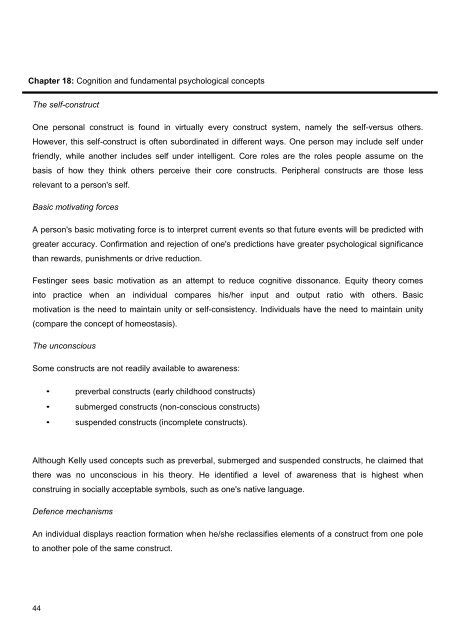IOP1601_MO001_3_2016_E
Create successful ePaper yourself
Turn your PDF publications into a flip-book with our unique Google optimized e-Paper software.
Chapter 18: Cognition and fundamental psychological concepts<br />
The self-construct<br />
One personal construct is found in virtually every construct system, namely the self-versus others.<br />
However, this self-construct is often subordinated in different ways. One person may include self under<br />
friendly, while another includes self under intelligent. Core roles are the roles people assume on the<br />
basis of how they think others perceive their core constructs. Peripheral constructs are those less<br />
relevant to a person's self.<br />
Basic motivating forces<br />
A person's basic motivating force is to interpret current events so that future events will be predicted with<br />
greater accuracy. Confirmation and rejection of one's predictions have greater psychological significance<br />
than rewards, punishments or drive reduction.<br />
Festinger sees basic motivation as an attempt to reduce cognitive dissonance. Equity theory comes<br />
into practice when an individual compares his/her input and output ratio with others. Basic<br />
motivation is the need to maintain unity or self-consistency. Individuals have the need to maintain unity<br />
(compare the concept of homeostasis).<br />
The unconscious<br />
Some constructs are not readily available to awareness:<br />
• preverbal constructs (early childhood constructs)<br />
• submerged constructs (non-conscious constructs)<br />
• suspended constructs (incomplete constructs).<br />
Although Kelly used concepts such as preverbal, submerged and suspended constructs, he claimed that<br />
there was no unconscious in his theory. He identified a level of awareness that is highest when<br />
construing in socially acceptable symbols, such as one's native language.<br />
Defence mechanisms<br />
An individual displays reaction formation when he/she reclassifies elements of a construct from one pole<br />
to another pole of the same construct.<br />
44


